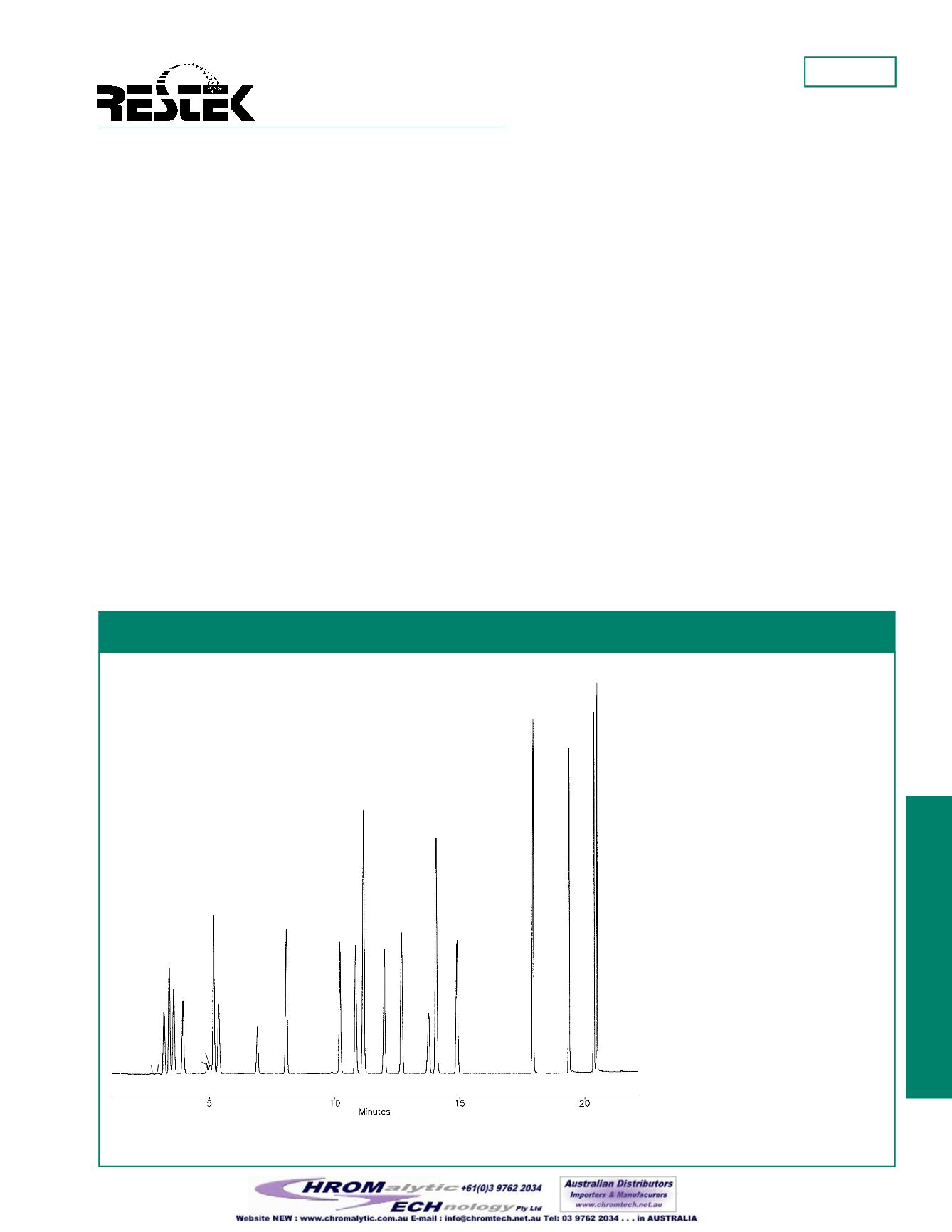
environmental
Applications
note
Restek Corporation • (800) 356-1688 • (814) 353-1300 •
#59345
ResolvingOxygenates fromGasolineAdditivesUsing anRtx
®
-VGCGCColumn
environmental
Figure 1–Using purge and trap concentration, theRtx
®
-VGC column resolves oxygenates and other
target gasoline compounds better than other columns specifically designed to resolveMTBE.
1 2
5
3
4
6
9
10
7
8
11
12
13 14
15, 16
17
18
20
21
22
23
24
25
30m, 0.45mm, 2.55µmRtx
®
-VGC (cat.# 19408); each component 100ppb in 5mL of ROwater, except tert-butanol 5000ppb; 2/1-methynapthalene 150ppb;
ethyl methyl benzene 50ppb.
GC:
Finnigan 9001;
Oven program:
40°C (hold 2min.) to 130°C@ 6°C/min. (hold 0min.) to 230°C@ 30°C/min. (hold 2min.).
Carrier gas:
helium@ ~8mL/min.;
Detector
: Finnigan PID, make up 7mLmin., purge 7mL/min., set @ 0.35mV, base temperature 200°C.
1. 2-methylpentane
2. 3-methylpentane
3. methyl-tert-buyl ether
4. tert-butanol
5. diisopropyl ether
6. ethyl-tert-butyl ether
7. isooctane
8. n-heptane
9. benzene
10. tert-amyl-methyl ether
11.
a,a,a
-trifluorotoluene
12. toluene
13. 1-chloro-3-fluorobenzene
14. ethylbenzene
15. m-xylene
16. p-xylene
17. o-xylene
18. isopropylbenzene
19. ethyl-methylbenzene
20. 1,3,5-trimethylbenzene
21. 1,2,4-trimethylbenzene
22. 4-bromochlorobenzene
23. naphthalene
24. 2-methylnaphthalene
25. 1-methylnaphthalene
GC_EV00465
19
itive results for MTBE, it is important to separate it from 2-
methylpentane and 3-methylpentane. Nonpolar phases (e.g., Rtx
®
-1
and DB-MTBE columns) have been recommended for separating
thesecompounds.However, thesephases are incompatiblewithpolar
compounds,which can result inbroader peaks and lower capacity for
the alcohols. Another potential interference for MTBE is
tert
-butyl
alcohol (TBA). The EPArecommends adding TBA to the target list
for contaminated sites known to containMTBEbecause it is abreak-
down product of MTBE and an additive in gasoline. Both of these
compounds respond on the photoionization detector (PID) and they
share ions using mass spectrometry (MS) detection, so MTBE and
TBAmust be resolved regardless of which detector is used.
The Restek Rtx
®
-VGC column is coated with a medium polarity
phase, which makes it ideal for the analysis of both hydrocarbons
and oxygenates. The unique polarity of this column improves the
separation of oxygenates, which results in more accurate detection
when using PID or FID. A 30m, 0.45mm ID, 2.55µm Rtx
®
-VGC
column helps determine low concentrations of oxygenates in
the presence of aliphatic compounds, resolving MTBE from
2-methylpentane, 3-methyl pentane, andTBA(Figure 1, peaks 1 to
4).These columndimensions allow for correct desorb flow rates from
With over onemillion underground fuel tanks in the United States,
contamination of ground and surface waters by gasoline in leaking
tanks has been an environmental problem for years. Recent events
have focused attentionon anew class of compounds associatedwith
gasoline leaks. These compounds, known as oxygenates—themost
common of which is methyl-
tert
-butyl ether (MTBE), are added to
gasoline to reduce overall emissions. Because oxygenates are polar
compounds and are soluble in water, they move through aquifers
easily. This poses a risk to drinkingwater supplies.
Avariety of methods have been used by environmental laboratories
to report oxygenates in gasoline, such as EPAMethods 8015, 8260,
8240, and8020. Someof thesemethods recommend flame ionization
(FID) or photoionization (PID) detection, while others recommend
gas chromatography/mass spectrometry (GC/MS). Environmental
samples contaminated with gasoline can contain both hydrocarbons
and oxygenates, and to identify oxygenates it is necessary to chro-
matographically separate them from the hydrocarbons.
The success of thesemethods is based on the ability of the analyti-
cal column to resolve oxygenates from the early-eluting alkanes,
alkenes, and, to a lesser extent, the alkynes. Tominimize false pos-


